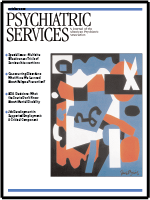An Innovative Inpatient Psychotherapy Unit in South Africa
To the Editor: The recently published World Mental Health Survey (1) has shown that depression and anxiety are at least as common as primary psychotic disorders. As such, these disorders demand the attention of mental health services. In South Africa, community and outpatient resources for individuals suffering from high levels of distress and trauma are limited. However, there is an innovative psychotherapy unit in Valkenberg Hospital in Cape Town, South Africa, which is an acute psychiatric hospital that serves a population of approximately one million. The unit was established at the hospital in the early 1970s after new wards were built.
Most individuals who are referred to the acute adult service have schizophrenia or bipolar mood disorder. Persons with anxiety or depressive disorders are not easily served in this high-turnover system, and a separate unit has been created to manage these problems. This separate unit admits men and women between the ages of 18 and 60 years. Individuals are usually referred to the program when they are experiencing a crisis, but they must be willing to take part in a weekly program. The referral problem is usually exacerbated by a range of psychosocial stressors.
Patients participate in a range of individual and group therapies. Groups are run by two facilitators three times a week. Brief-term individual therapy is offered by case managers; life skills and goal-setting groups and psychoeducation sessions form part of the weekly program. The unit has a consultant psychiatrist, a psychiatric registrar, a psychologist, and a psychology intern. Nursing staff play a supporting role but do not manage cases. In general, patients with active psychosis and suicidal ideation are excluded from the program. A collaborative approach is encouraged, with the main goals of the admission being to ameliorate psychiatric symptoms and promote reintegration into the community. Psychosocial needs are addressed when brought as a focus for clinical attention. In most cases this involves creating a care plan that extends beyond the admission into community care.
A survey of this unit was conducted from January 2003 through January 2004. The study was approved by the research ethics committee of the health sciences faculty at Cape Town University, and all participants gave informed consent. We found that two-thirds of the patients in the unit were women (74 patients), and most (92 patients) had some type of depressive disorder. Anxiety disorders and borderline personality disorder were common—of the 100 patients surveyed, 32 had borderline personality traits. The mean±SD length of stay was 5.7±2.4 weeks. Among the patients with depression, 87 (90 percent) reported having received a moderate or high degree of help.
This inpatient psychotherapy unit plays an important role in addressing a range of psychiatric problems in our service. However, ongoing evaluation of the program and its relevance to patients is recommended.
The authors are affiliated with the department of psychiatry and mental health of the University of Cape Town in South Africa.
1. The World Mental Health Survey Consortium: Prevalence, severity, and unmet need for treatment of mental disorders in the World Health Organization World Mental Health Surveys. JAMA 291:2581–2590,2004Crossref, Medline, Google Scholar



